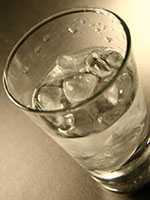CDC at Work: Drinking Water
CDC experts work to address drinking water issues that affect public health through various research, prevention, and policy activities and programs. This work spans many disciplines and includes:
Research on Health Impacts

- Providing support for state and local health officials to investigate, report, and prevent illnesses associated with drinking water systems.
- Providing outbreak and consultative assistance.
- Identifying and tracking the causes and sources of parasitic and waterborne disease.
- Estimating the number of illnesses and costs associated with waterborne disease and outbreaks.
- Identifying the health impacts of climate change, aging drinking water infrastructure, and well water usage to develop strategies for improvement.
- Identifying and analyzing environmental factors that contribute to waterborne disease.
- Developing improved laboratory methods for sampling, testing, and monitoring water quality.
- Developing tools and training to improve waterborne disease outbreak investigations.
- Assessing the health effects of backcountry water use in national parks (collaboration with the National Park Service).
Tracking Disease
- Building national surveillance (tracking) capacity for waterborne disease and outbreaks
- Operating the national Waterborne Disease and Outbreak Surveillance System (WBDOSS) to collect data on waterborne disease and outbreaks in the U.S.
- Reporting national notifiable disease surveillance data for common waterborne illnesses such as cryptosporidiosis and giardiasis.
- Collecting and reporting surveillance data for free-living amoebae infections (Naegleria, Balamuthia, Acanthamoeba).
- Building CryptoNet, a national DNA-based molecular surveillance system for understanding U.S. transmission of cryptosporidiosis.
Development of New Laboratory Methods
- Developing and testing performance of disinfection and filtration systems for waterborne pathogen inactivation or removal.
- Developing recommendations for treating swimming pools following contamination.
- Testing the disinfectant sensitivity of waterborne pathogens in drinking and recreational water.
Policy and Public Outreach
- Working with the Environmental Protection Agency (EPA) and other partners to provide guidance on drinking water policy and research priorities.
- Developing a National Well Data Repository to support public health decision making for well water.
- Applying study findings to improve waterborne disease prevention outreach, education, policies, and practices.
- Providing national leadership on community water fluoridation practice.
Collaboration and Partnerships
- Supporting EPA and other partners in performing their duties and responsibilities related to protecting national drinking water.
- Guiding the planning, implementation, and evaluation of programs that promote water safety.
- Strengthening the collaboration among epidemiology, laboratory, environmental health, and regulatory programs to prevent waterborne disease.
- Conducting lab-based disease surveillance of foodborne, waterborne, and diarrheal diseases.
- Developing and implementing prevention strategies for waterborne diseases in consultation with regulatory agencies and the food industry.
Information Dissemination
- Developing and improving access to water-related health and prevention information through expansion of the content and resources on the Healthy Water website.
- Promoting national drinking-water related observances.
- Developing guidance in collaboration with other partners for communications planning [PDF - 162 pages] during emergency events such as drinking water advisories.
- Page last reviewed: September 13, 2012
- Page last updated: September 13, 2012
- Content source:


 ShareCompartir
ShareCompartir